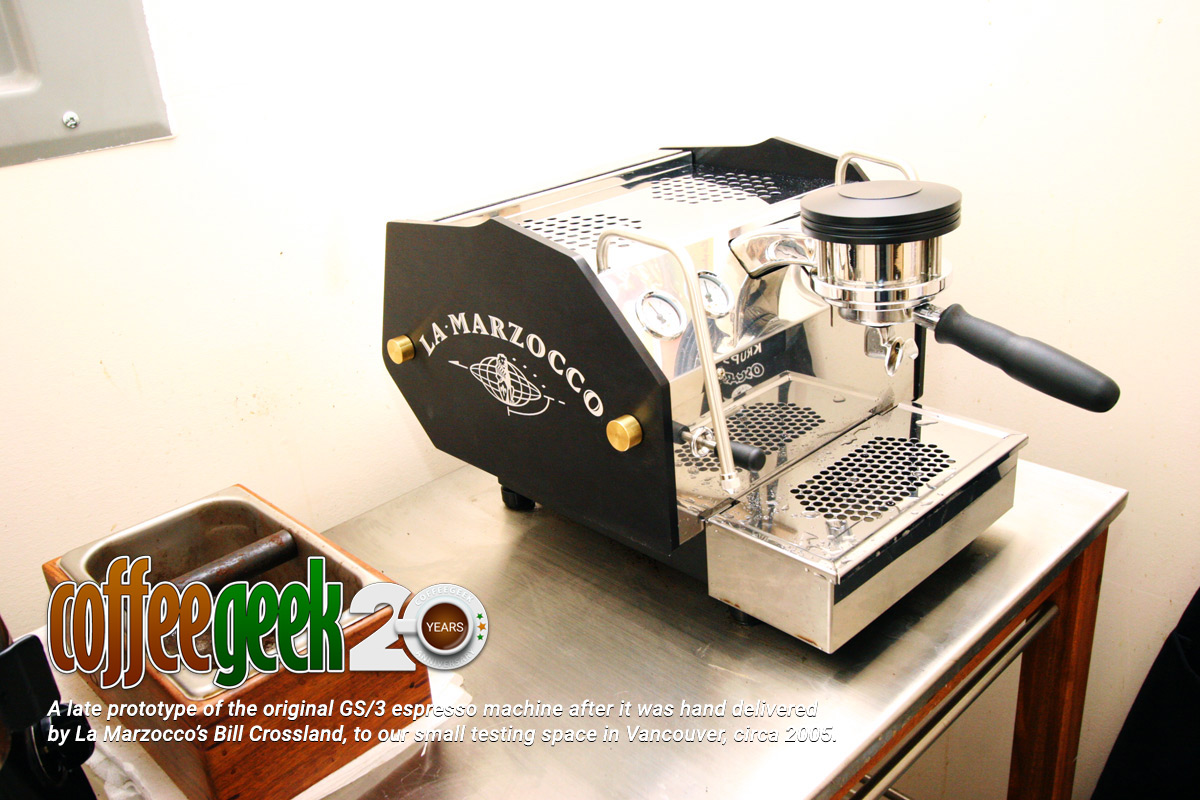Products You May Like
This is a three part series of blog posts delving into the people and companies that where either heavily involved with CoffeeGeek and its community, or heavily influenced by CoffeeGeek and it’s community. The first part, which focused on the two owners of Baratza and how they were a big part in CoffeeGeek’s early foundation and reach, can be found here.
In this second part, we’re focusing heavily on the espresso world of the late 1990s and early 2000s. Prior to the launch of CoffeeGeek, there wasn’t any website online where people who loved espresso, or wanted to learn about espresso, could congregate. Indeed, most of that congregation and interaction between espresso lovers took place in a newsgroup called alt.coffee, part of the Usenet discussion board service that predated the Internet.
The La Marzocco Connection
That’s where I first interacted with Joe Monaghan, who just happened to be a co-owner Espresso Specialists, Inc. (ESI) a company that owned a 90% stake in La Marzocco, which was (and is) considered one of the best espresso machine manufacturers in the world. A year before CoffeeGeek was born, Joe invited me down to Seattle to tour the La Marzocco works, where they built all the machines for Starbucks. A few months after CoffeeGeek was born, Joe again invited me to Seattle, but this time to meet the other principles with ESI / La Marzocco, and also to consult on the design of a brand new espresso machine (which would become the La Marzocco GS3).
Honestly, I didn’t know what I was getting into, and certainly did not have the real expertise to consult on the building of a high end, standards breaking machine like the GS3. But several things from that meeting happened. First, I met some absolutely brilliant espresso people, including John Blackwell and Kent Bakke, the latter which would go on to be a dear friend ever since. Second, just being involved with La Marzocco in any capacity raised the “cred” level of CoffeeGeek within the specialty coffee community by a massive amount. And third, I realised that summer that if people were going to treat me as some kind of “expert” in coffee and espresso, I better damned well start working on actually becoming more knowledgeable on the subject.
The next three years, I dedicated myself to just that. I took courses at the Specialty Coffee Association of America (SCAA) trade show in espresso, coffee roasting, and coffee brewing. I was certified as a regional, then national, then world level barista championship judge (more on that below). Eventually, after years of picking the best brains in the world of espresso, I felt confident enough to help write new espresso training courses for the SCAA (as part of the short-lived Consumer Marketing Group), and consult on other espresso training courses for them and other national trade associations.
Kent Bakke was a huge, huge part of that learning and training. He opened doors for me, spoke for me, educated me and introduced me to a wide range of people with immense espresso knowledge.
I took all that, and shared it willingly with our writers at CoffeeGeek; I would put them in touch with experts Bakke opened doors for us to; I wrote about what I learned in my interactions with La Marzocco and the ongoing development of the GS3 project. For 18 months, I had a prototype machine at my home, reporting back to Bill Crossland, the chief engineer of the GS3, and learning more and more about the science and exactness of espresso.
(as a sidenote, the GS3 was a complete game changing machine; it was the espresso industry’s first attempt at delivering espresso brewing temperatures down to .1F accuracy at the grouphead; the engineering and development of the GS3 led to the La Marzocco GB5 being introduced for sale in 2005, which was the world’s first commercially available .1F accurate grouphead temperature commercial espresso machine, beating the launch of the GS3 by a few months.)
That time with the prototype GS3 taught me more about espresso science and mechanics than anything else I’ve done or studied on espresso. The near-weekly private feedback with Crossland at ESI meant everything we wrote for CoffeeGeek – everything I wrote, and everything I edited from our writers on espresso – got better, richer, and in some cases, ground breaking. Here’s one example of that.
No Knock Tamping
Right up to the early 2000s, it was common for baristas to tamp down their coffee in a portafilter basket, then flip the tamper, knock the side of the basket, and do one final tamp down. The idea was, the knock would settle any coffee caught on the sides, and the final tamp would press that stray coffee down and complete the puck.
Today, high end professional baristas don’t knock their portafilters any longer, and that’s because of CoffeeGeek and La Marzocco. You see, in the early 2000s La Marzocco developed the Swift grinder which is the first coffee grinder designed to tamp and compress the coffee into a portafilter as it delivered the ground coffee. On one of my tours, I was shown a Swift prototype and had a long discussion with John Blackwell, one of the engineers who developed it. I asked how much tamping pressure is applied. Blackwell initially said 30 pounds (the industry standard at the time) but then checked himself… “it’s 8 pounds!”. I asked him why so low.
“The Swift tamps as the coffee is delivered into the basket, so it’s always compressing the coffee. We found when we set it up for 30lbs pressure, it created a puck that was so compacted, water at 9BAR pressure could not push through it. So we settled on 8lbs pressure, which in a way mimics the 30lb press, top down that a barista’s hand woud do.”
This started a long term discussion about espresso preparation, tamping, and the methods involved. What the development of the Swift showed us was that, when you compress a bed of coffee with a tamper in a traditional way, you’re only compacting the top few milimeters of the bed of coffee; everything below that isn’t really affected in a fully loaded filter basket.
All this led to even more discussion and debate. Well, if you aren’t compacting the bottom half or third of the bed of coffee, what happens when you do a violent knock against the side of the portafilter when prepping your coffee? Water, under pressure, always seeks the path of least resistance. If you knock the side of a fully loaded portafilter, a gap between the filter basket wall and the ground coffee could be created, thus giving water it’s easy flow path around the sides of the puck, instead of through all of it evenly.
And still more discussion: if tamping doesn’t settle and compact the coffee in the lower 2/3rds of a filter basket, how do you achieve that? One method we developed in the CoffeeGeek forums was “knocking” the portafilter down onto an espresso grinder’s forks as the coffee was loading up – this compacted the bed of coffee as it was loading up, settling the grinds into a more uniform compaction than doing nothing but tamping at the end.
At CoffeeGeek, we organized tamping technique events and tests with large groups, both in our own mediocre testing facilities (my basement) and at cafes; we also organized gatherings at trade shows to work on developing new parameters for how to tamp coffee better for espresso.
I could go on, and perhaps I will in another feature article about this, but suffice to say, much more debate and discussion took place on this subject: at La Marzocco, in our forums, at trade shows, in front of espresso machines at barista jams, and more. By 2005, the general consensus was – knocking your portafilter after tamping was very bad, and should be eliminated from a professional barista’s method of preparing espresso. It took years, but today, you’d be hard pressed to find a top flight barista who still knocks the portafilter.
I talked about our forums on the old CoffeeGeek site a lot above, and that’s where the next part of this look back goes.
Barista Champions and Competitions
CoffeeGeek was the first website to ever cover, feature, and report from barista championships and barista gatherings, called Jams. Our first ever was the Northwest Barista Jam, which we reported on in February, 2003. We did also cover the one and only North American Barista Championship several months earlier (it was held at the 2002 SCAA Trade Show in Anaheim) but it was more of an after thought.
For the next five years, I made it a mission to cover as many barista competitions that I could on CoffeeGeek. We had writers covering them in Scandinavia, the UK, Italy, the USA and Australia. We introduced coffee consumers to people like Tim Wendelboe, Fritz Storm, Paul Bassett, Heather Perry, Klaus Thomsen, Sammy Piccolo, Carl Sara, Matt Riddle, Stephen Morrissey, Gwilym Davies, David Makin, and James Hoffmann, just to name a few.
In fact, many of those folks were participants in the CoffeeGeek forums before competing in national and world barista championships. Many of them first found out about Barista Championships because we covered the competitions on CoffeeGeek. I know Riddle, Morrissey, and Makin in particular discovered barista competitions through CG.
One of the names listed above might be really familiar to you: James Hoffmann. Long before he became one of the most recognized and trusted Youtube sources of coffee and espresso information, long before he won the World Barista Championship, Hoffmann was a participant in our forums and for a short time, a columnist on the CoffeeGeek website. He was part of the debates on tamping styles, milk science, and the chemistry of coffee and espresso. He contributed to the collective evolution of espresso that was happening in our forums, and he no doubt learned a lot of his craft from the same sources.
For five solid years, I dedicated a lot of CoffeeGeek’s resources and money to covering barista championships and events (as an example, in 2005, we spent over $14,000 just to cover barista competitions for that one year). I was also a certified World Barista Championship (WBC) judge, and had become disillusioned with the competitions and its organizers.
More importantly, our readership had expressed (through various polls we had at that time) a declining interest in barista competitions. There was a real feeling with enlightened coffee and espresso consumers that the state of barista competitions in 2006, 2007 no longer related to what consumers wanted from better espresso.
Because of that, CoffeeGeek changed policies on barista competitions and their coverage in 2007: we’d no longer cover the international ones unless we could find local reporters to do so, or they were at the SCAA’s Annual Trade Show. Outside of the USBCs and WBCs at SCAA, we would only cover regional events in the Pacific Northwest. That year, the WBC was in Japan, and it would be the first WBC we would not have daily reports from in five years.
Not many of our regular readership cared much, but I still did: so much so that when I heard about two bloggers who really wanted to do their own style of reporting and coverage of barista competitions, I donated $1,500 to them so they could travel from the USA to Japan to cover the WBC in 2007. It was a pure donation – they didn’t write for CoffeeGeek, and everything they wrote and blogged about went on their own website. We just pointed our readers to their content at the time.
That young blog? Sprudge.
In the last of this three part series, we’ll be talking about some of the true giants in specialty coffee, as well as some of the companies who really helped CoffeeGeek develop it’s identity in the 2000s. It’s coming tomorrow.






